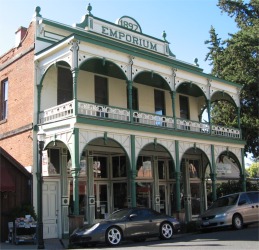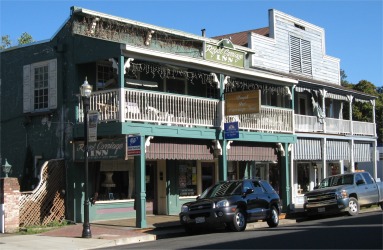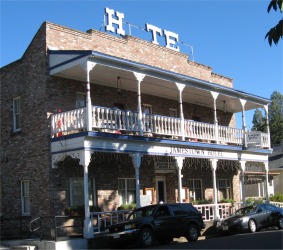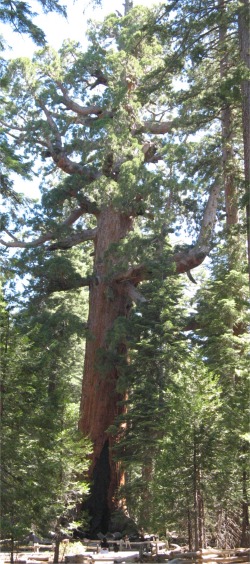 Grizzly Giant with a 30' Cropping Due to a Lightning Strike |
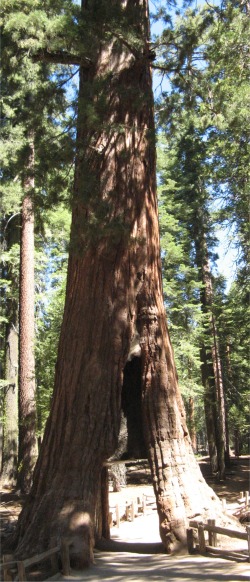 California Tunnel Tree |
As soon as I arrived, I latched on to a ranger guided tour. John, the ranger, was an endless source of one liners, and well informed on his subject. He guided us as far as the Grizzly Giant in the lower grove, before letting us go and explore the upper grove ourselves.
He explained that the Giant Sequoias are only found on the central and southern slopes of the western Sierra Nevada. They occurred in groves, of which there were 75 alongside the mountain range.
The coastal redwoods were taller, and proved to be a good source of timber. The Giant Sequoias, however, did not hold much value from a timber sense, due to their brittleness. I saw examples around me of sequoias that had fallen down or had been chopped down. When the trunks hit the ground, they broke up into pieces.
He pointed out other curious features too. All the downed trees, which were on slopes, fell facing up the slope. The reason for that was as follows; when a sequoia grew, it would start to shed lower branches as a form of protection from fires. The lower branches would hit the ground, break, and roll downhill. Those rolling down towards a tree would accumulate on the upward side of the tree. Any lightning-caused fire would burn fiercely where the branches accumulated, forming a weakness on the up hill facing side. If the tree didn't topple then, it would normally do so in winter winds, or when heavy snow fell on the remaining branches, tipping the balance.
 The Clothespin Tree |
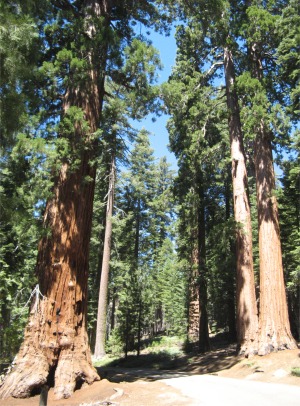 Conversation Across the Road |
Lightning-caused fires reduced the competition from other evergreens, burnt away the leaf litter, and left a thin layer of nutrient-rich ash over the mineral soil. Also, heat from the fire dried some of the mature trees' green sequoia cones, causing a shower of fresh seeds to fall onto a perfectly-prepared seedbed. When winter came, snow blanketed the Mariposa Grove. As the snowpack melted the following spring, sunlight, moisture, fresh seeds, ash, and mineral soil combined to create a sequoia nursery.
The National Park Service began a series of "prescribed burns," that were deliberately set and closely monitored by rangers. When the forest returns to a more natural state, the management fires would probably be discontinued. Then nature could resume its cycle of lightning-caused fires every 7-20 years.
The Grizzly Giant was one of the largest trees in the Mariposa Grove. The huge limb on its south side was seven feet in diameter. Some 45m beyond the Grizzly Giant was the California Tunnel Tree, cut in 1895 to allow horse drawn stages to pass through.
I continued walking around the lower grove and upper grove, where even more sequoias could be found, some with fanciful names such as Faithful Couple (two trees had fused together at the base), the Clothespin Tree, and Telescope Tree (so called because it was completely hollow all the way up).
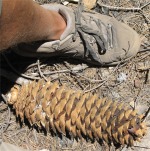 Sugar Pine Cone |
Confronting the sheer size and age of these trees was a humbling experience. The bristlecone pines were older, but not as imposing as these giants.
I left Mariposa Grove feeling as though I had been put in my place, and took the tortuous route back to the valley. Once there I headed up to the 120 and drove west through the never ending Stanilaus Forest to Highway 49. From there it was "Go north old man". The 49 was aptly named, it was a main artery through the Gold Country during the gold rush area.
Located at the heart of California in the foothills of the western Sierra Nevada, the Gold Country was at one time a real life El Dorado, where a thick vein of gold sat waiting to be discovered. Once home to the Miwok and Maidu people, the gold rush turned the quiet region into a lawless jamboree of gold miners from all over the world. But the boom went bust by 1860. A few years later, the area saw another short-lived boom, when the transcontinental railroad was constructed through the Sierra Nevada mountains by low-paid labourers, many of whom were Chinese.
As I drove north through straw coloured, grassy, undulating hills, I came across Jamestown and pulled in to its main street for an explore. It looked as though nothing had changed over the last 160 years, a proper cowboy town with a tar macadam road. There were plenty of eating establishments, quaint tea-rooms, hotels, gift shops, and antique shops. It could have been anywhere in the UK. It certainly pulled in the tourists though.
|
|
|
However, it lacked a campsite, so I drove further north. As I passed through Sonara, which was a much bigger town, it too had retained a lot of the original architecture. It was also heaving with people.
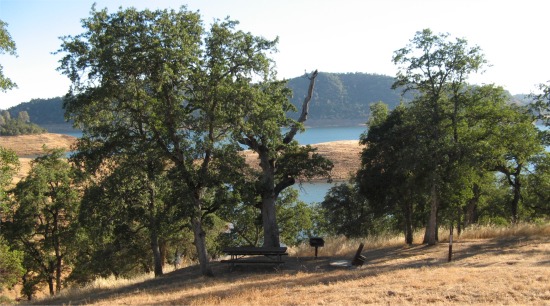 My Melones Dam Campsite |
The long-winded drives I had done through the day had put me off the idea of a quick explore of the locality. I needed some food, and I didn't have the energy to cook, so I asked the guys at the campsite entrance what was available nearby. They informed me that a couple of miles back down the road, there was the Beer Bar, which served good sandwiches. Off I went.
I walked into the bar, which also served as a country shop. The place was deserted apart from a young woman behind the counter. She described the two options available to me with such rapidity that I had to ask her to repeat it. I was still bewildered when she did, so I opted for the first option.
Off she went into the depths of the building, and I took a seat at the bar and looked around at all the John Wayne memorabilia adorning the walls. Eventually she returned with a long rolled brimming with tender beef. That was fine with me and I tucked in.
Just then three chaps appeared, a guy my age and two younger fellows. They ordered beers and started playing pool. Boy oh boy were those blokes loud, especially the older one. Talk was not in their vocabulary, only shout. There was some banter between them and the girl; they all knew each other. After a while, I noticed one of the grizzlies turn around and look at me. I soon snapped out of my oblivion and cottoned on that the girl had said something to me and I had failed to respond. I apologised and asked her to repeat it.
She was just asking me what I was doing out in this neck of the woods. I explained I was exploring the Gold Country as part of my overall trip. She showed some interest in this, but was dragged off to do some chores elsewhere. The noise enforcement crew moved on and I was left to eat in peace.
The young woman returned and started telling me about a trip she once had to Mexico. I asked her if she had traveled to Europe, and her face lit up as she told me she would love to travel to Europe, and especially travel on the Eurostar train. I soon discovered that she had never been on a train, never ridden a bicycle, and never been on a large ship. I could understand the latter, unless you wanted to sail out to islands close to the American coast, there would be no need to take a big ship.
I told her I thought she had lived a sheltered life, and I quickly found out that she had been through a series of bad relationships where she was continually put down, and that had stunted her branching out into the big wide world. She did seem rather vulnerable. However, she did have that spark of ambition that she would love to travel, or maybe just a dream. I hoped my travel epic inspired her to just go do it. I offered words of encouragement and wished her luck as I departed.
I got back to camp and just curled up to sleep.

